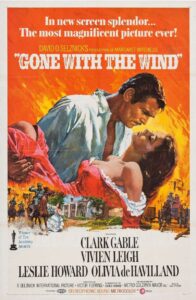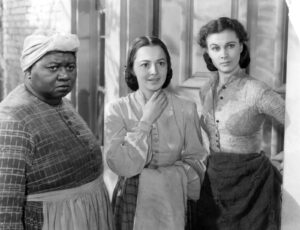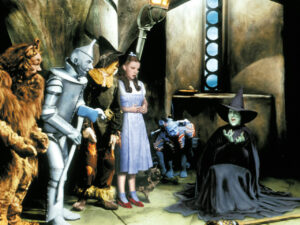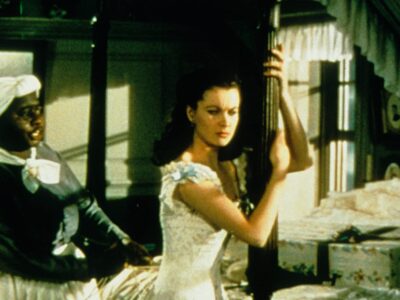A Tale of Two Heroines: Revisiting the Past with Gone with the Wind (1939) and The Wizard of Oz (1939)
 In the year 1939, two blockbuster movies burst onto the big screen in brilliant technicolor, forever changing the face of American film: Gone with the Wind and The Wizard of Oz. On the surface, the heroines of both films have much in common. Scarlett O’Hara and Dorothy Gale are both small town, teenage girls with long, auburn hair. Both possess strength of mind and will. Both faced deadly storms: one, a literal tornado and the other, the metaphorical storm of the Civil War, the deadliest war ever fought on American soil. This is, however, where the similarities end. The movies remain timeless more than 80 years since their debut. This is mainly because of their vibrant female leads and the ways they speak to generations of moviegoers, past and present. The enduring appeal of these films lies in how Scarlett and Dorothy experience different fates based on their relationships with people, the past, and perspective.
In the year 1939, two blockbuster movies burst onto the big screen in brilliant technicolor, forever changing the face of American film: Gone with the Wind and The Wizard of Oz. On the surface, the heroines of both films have much in common. Scarlett O’Hara and Dorothy Gale are both small town, teenage girls with long, auburn hair. Both possess strength of mind and will. Both faced deadly storms: one, a literal tornado and the other, the metaphorical storm of the Civil War, the deadliest war ever fought on American soil. This is, however, where the similarities end. The movies remain timeless more than 80 years since their debut. This is mainly because of their vibrant female leads and the ways they speak to generations of moviegoers, past and present. The enduring appeal of these films lies in how Scarlett and Dorothy experience different fates based on their relationships with people, the past, and perspective.
People
Perhaps the starkest difference between the two heroines is how they view and interact with people. Scarlett O’Hara (and, presumably, Gone With the Wind author, Margaret Mitchell) judged individuals based on race, class, and birthplace. Recently, HBO removed the Oscar-winning classic from their streaming service, based on its racist tone and inaccurate, sanitized portrayal of slavery in the south. (They have since returned it to their service with a disclaimer contextualizing the portrayals in the film). Throughout the movie, Scarlett seems to relate with individuals solely based on what she can get from them. Her betrayals of loved ones and enemies alike prove Scarlett’s loyalty to just one cause: Scarlett.
 Dorothy Gale, on the other hand, treats everyone she encounters with kindness, grace, and humility. Though she seems to take her guardians for granted in the beginning of the film, she learns to appreciate their care for her by the end. She shows love and compassion to creatures and humans alike, even those from vastly different backgrounds who look and act differently from anyone she’s ever known. She even learns to treat her enemies with civility and shows remorse for her role in the deaths of the story’s two main villains.
Dorothy Gale, on the other hand, treats everyone she encounters with kindness, grace, and humility. Though she seems to take her guardians for granted in the beginning of the film, she learns to appreciate their care for her by the end. She shows love and compassion to creatures and humans alike, even those from vastly different backgrounds who look and act differently from anyone she’s ever known. She even learns to treat her enemies with civility and shows remorse for her role in the deaths of the story’s two main villains.
It is this ability to grow and change that brings us to the next difference between the young ladies’ points of view.
The Past
“Well, I guess I’ve done murder. I won’t think about that now. I’ll think about that tomorrow. ” — Scarlett O’Hara
 Scarlett spends much of the film stuck in the past, yet refusing to learn from it. Her childhood crush remains unabated by his marriage to another woman and the three short-lived marriages of her own. Despite seeing the South burn around her during the Civil War, she is determined to keep her plantation and southern way of life, by replacing runaway slaves with her own family and, eventually, prison labor.
Scarlett spends much of the film stuck in the past, yet refusing to learn from it. Her childhood crush remains unabated by his marriage to another woman and the three short-lived marriages of her own. Despite seeing the South burn around her during the Civil War, she is determined to keep her plantation and southern way of life, by replacing runaway slaves with her own family and, eventually, prison labor.
The Bible is full of warnings about longing for the past. King Solomon, warns, “Don’t long for ‘the good old days.’ This is not wise” (Ecclesiastes 7:10 NLT). My work with addicts and alcoholics has taught me the folly of yearning for the past lies in refusal to learn from it. Throughout Gone With The Wind, Scarlett recycles the same bad decisions, often with tragic costs. By the conclusion of the film, she has lost everything except the dirt beneath her feet, yet stubbornly declares, “Tomorrow is another day!”
Dorothy braves an F5 twister, a wicked witch’s threats, flying monkeys and opioid poisoning on her quest to return to her family in Kansas. Rather than being hardened by these trials, she learns to appreciate and long for her true home, especially the people who love her best. After being shipwrecked, beaten, jailed, and worse, the apostle Paul admonishes the church in Rome, “We can rejoice, too, when we run into problems and trials, for we know that they help us develop endurance. And endurance develops strength of character, and character strengthens our confident hope of salvation” (Romans 5:3-4 NLT). Even during the merry times, this world is not our home.
Perspective

This perspective highlights another difference between these two ladies: attitude. Much as Scarlett expects the people around her to bend to her whims, she expects the world around her to do the same. She is consistently looking away when life doesn’t give her what she wants. When her suitors speak of impending war, she will not hear of it and threatens to go home if they don’t stick to happier subjects. Rather than face a soldier’s amputation, she abandons her nursing duties. Her stormy temper rises when life doesn’t bend to her whims and she eventually turns to alcohol rather than face the perils of war.
Dorothy, on the other hand, expresses optimism, determination, and kindness no matter what life throws at her. She sticks to her goal, unabated by danger, and maintains a contagious enthusiasm for seeking Oz…and home.
In the Storm
Jesus promised us, “Here on earth you will have many trials and sorrows. But take heart, because I have overcome the world” (John 16:33 NLT). Rather than let our past and improper perspectives on others and our life embitter us, let us grab a few seekers and hop on that yellow brick road to find our way home. The journey might be treacherous, but, if we stay on the path, we just might encounter wisdom, love, courage, and friendships like we’ve never known before.
Candice Lee Brown, a Colorado native, writes from the Mile High City of Denver. When she’s not writing, teaching preschoolers, or single-mothering, she’s devoting time to helping women overcome hurts, hang-ups and habits through Celebrate Recovery and Alcoholics Anonymous. Candice publishes a blog, “Intentional Overcomer,” every Monday at candiceleebrown.com/blog and is currently editing her first novel. You can find her on Twitter and Instagram at @candiceleewrite. View all posts by Candice Brown






